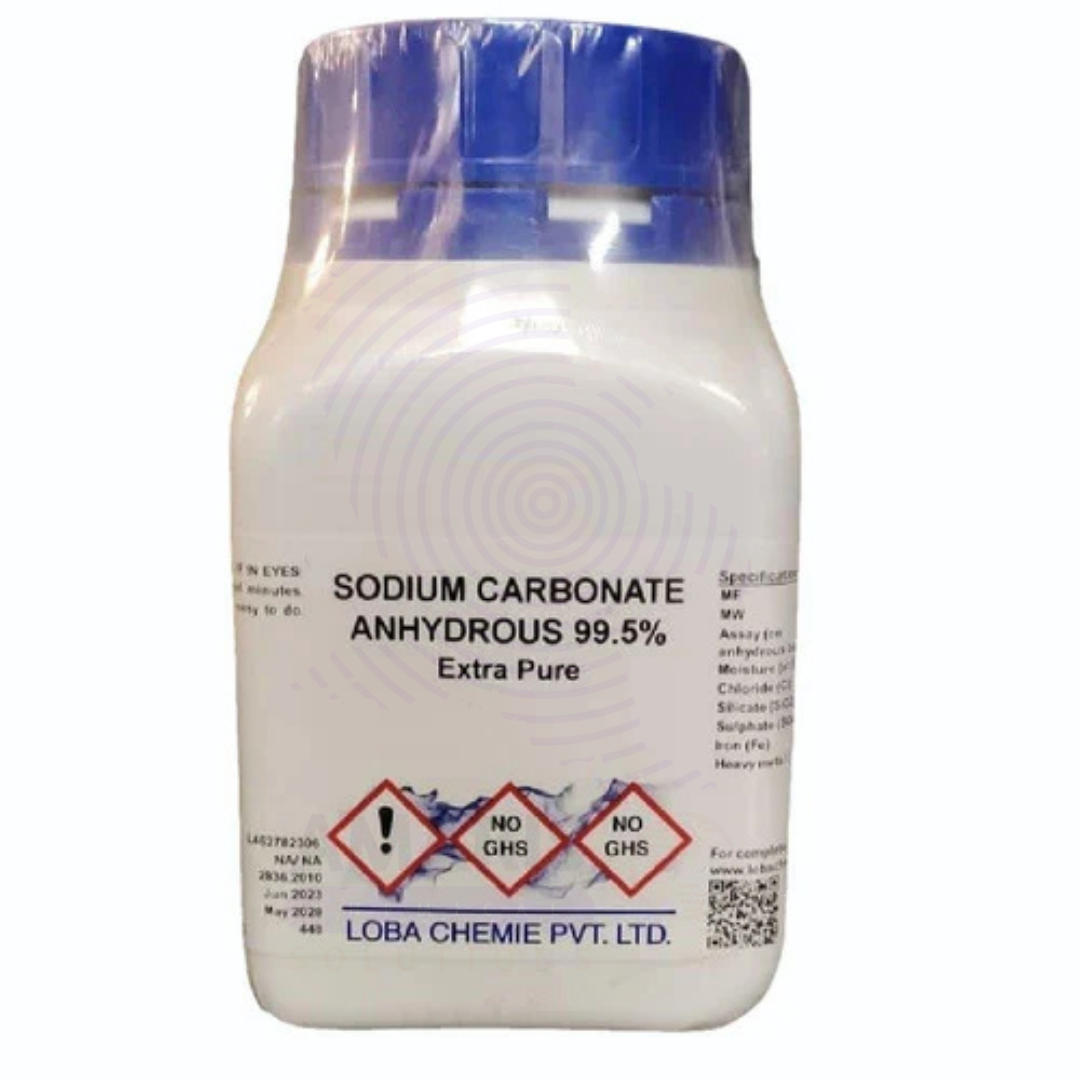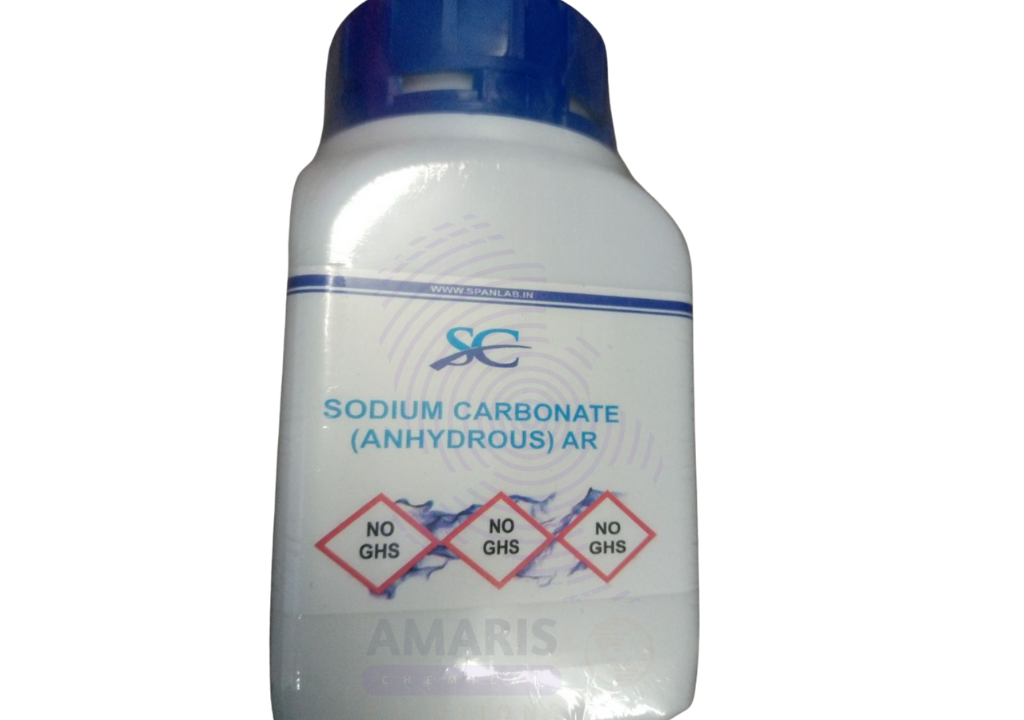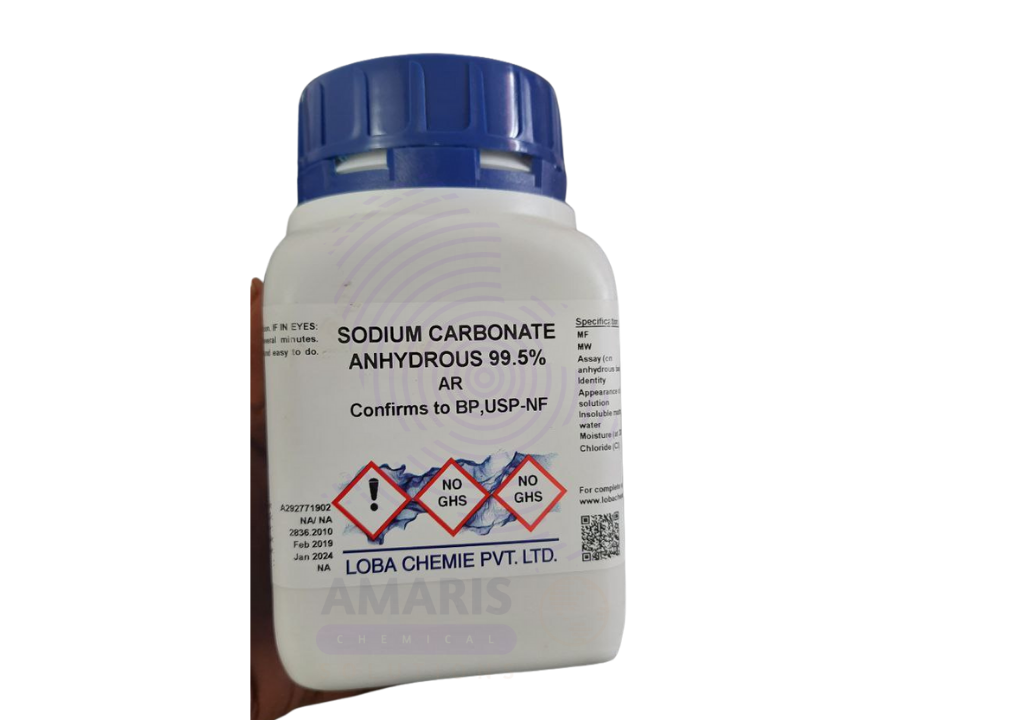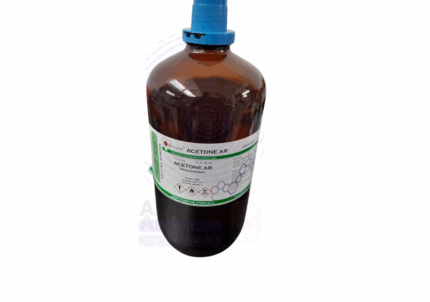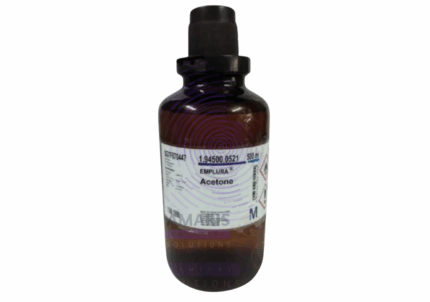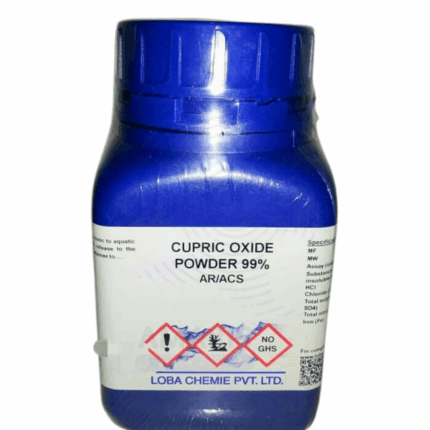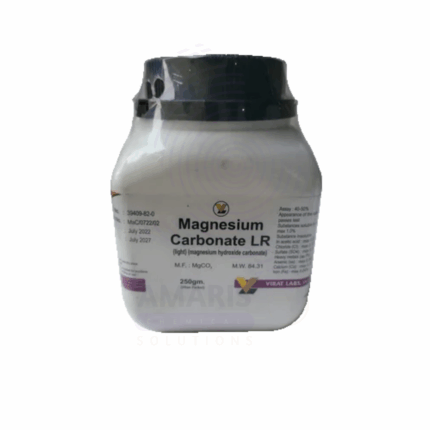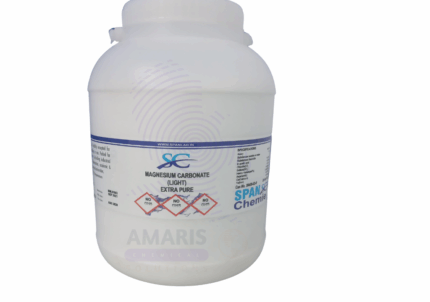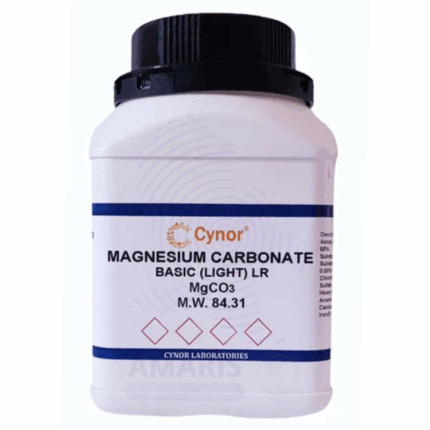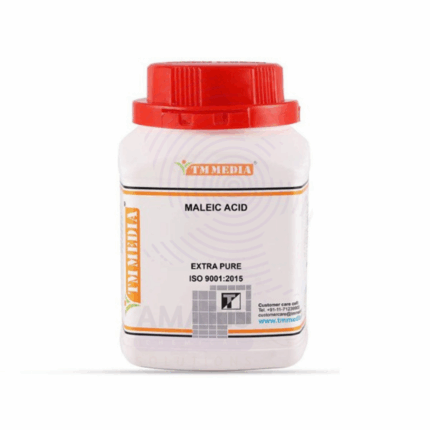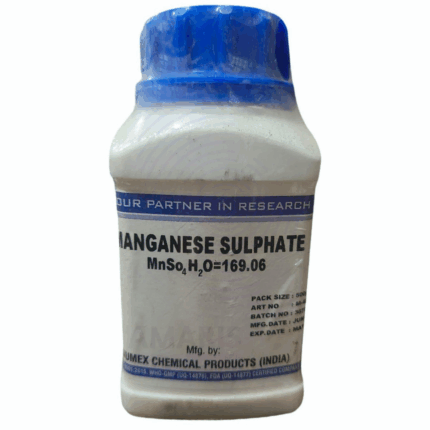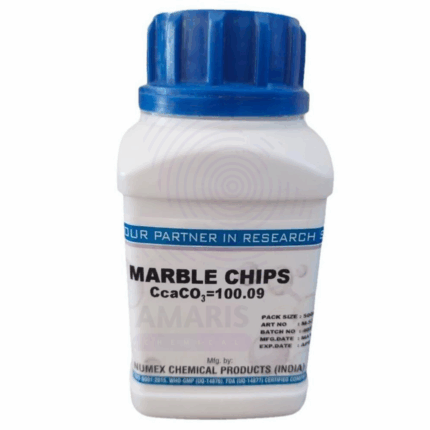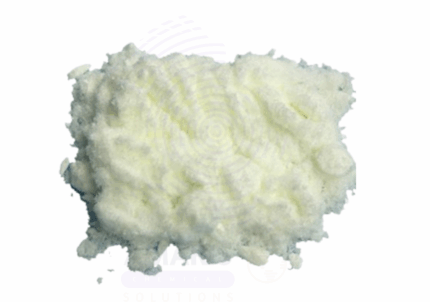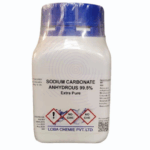
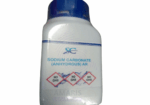
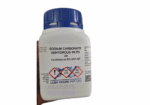

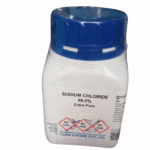
Sodium Carbonate Anhydrous Extra Pure
$ 19.79 Original price was: $ 19.79.$ 19.67Current price is: $ 19.67.
Sodium Carbonate Anhydrous Extra Pure is a high-purity, white crystalline or powdery inorganic salt known for its strong alkalinity and water solubility. Commonly referred to as soda ash, it is widely used in laboratory analysis, pH regulation, chemical synthesis, glass manufacturing, and as a food additive (E500ii). Its consistent quality and chemical stability make it suitable for high-precision applications in research, industry, and regulated production environments. It must be stored in a dry, sealed container to prevent moisture absorption and degradation.
Sodium Carbonate Anhydrous Extra Pure
PRIMARY USES
- Analytical Reagent & Laboratory Applications:
Used as a primary standard in acid-base titrations
• Acts as a buffering agent in analytical chemistry and sample preparation
• Utilized in qualitative and quantitative analysis for carbonate and bicarbonate detection - Glass & Ceramics Manufacturing:
Essential fluxing agent in glass and ceramic production
• Lowers the melting point of silica, improving manufacturability and durability of glass
• Used in enamel and frit formulations for better fusion - Pharmaceutical & Cosmetic Industry:
Functions as a pH adjuster in pharmaceutical formulations
• Used in skin-care products and toothpaste for its alkalinity and mild cleansing effect
SECONDARY USES
- Food Industry (regulated quantities):
Employed as a food additive (E500ii) for pH regulation and leavening in bakery products
• Used in cocoa processing and ramen noodle production to modify texture and flavor - Chemical Manufacturing:
Intermediate in the production of sodium compounds such as sodium silicates and phosphates
• Used in detergent production as a water softener and alkaline builder - Water Treatment:
Helps adjust pH in water treatment systems
• Precipitates hardness ions to improve water quality - Textile & Dyeing Industry:
Used to fix reactive dyes onto cotton fibers
• Acts as a cleansing and neutralizing agent during textile processing
1. Basic Identification Attributes
- Chemical Name: Sodium Carbonate (Anhydrous)
• CAS Number: 497-19-8
• HS Code: 2836.20.00
• Molecular Formula: Na₂CO₃
• Synonyms:
- Soda ash
- Disodium carbonate
- Anhydrous soda
- Carbonic acid disodium salt
2. Physical & Chemical Properties
Physical State: White, granular or powdered solid
• Color & Odor: White, odorless
• Melting Point: ~851 °C
• Boiling Point: Decomposes before boiling
• Density/Specific Gravity: ~2.53 g/cm³
• Solubility:
- Soluble in water (~22 g/100 mL at 20 °C)
- Insoluble in alcohol
• pH Level: Strongly alkaline (pH ~11.5 for 1% solution)
• Vapor Pressure & Volatility: Not volatile
• Flash Point: Not applicable
• Autoignition Temperature: Not applicable
• Viscosity: Not applicable
3. Safety & Hazard Attributes
Hazard Class (GHS Classification):
- Eye irritation (Category 2A)
- Skin irritation (Category 2)
• NFPA Ratings: - Health: 2
- Flammability: 0
- Reactivity: 0
• Exposure Limits: - No specific OSHA PEL or ACGIH TLV established
• Reactivity: - Stable under normal conditions
- Reacts with acids to produce CO₂ gas
4. Storage & Handling Attributes
Storage Conditions:
- Store in a dry, cool, well-ventilated area
- Keep containers tightly closed to avoid moisture uptake
• Incompatible Materials: - Acids (reacts to release CO₂)
- Moist air (hygroscopic)
• Container Type: - Polyethylene or sealed metal drums
• Shelf Life & Expiration Date: - Stable for several years under dry storage
• Special Handling Requirements: - Use gloves and goggles
- Avoid generating or inhaling dust
5. Regulatory & Compliance Attributes
Regulatory Status:
- Approved for use as a food additive (E500ii)
- Listed under REACH, OSHA, EPA, and FDA
• Transportation Restrictions: - Not classified as hazardous for transport
• Waste Disposal Method: - Dispose of in accordance with local environmental regulations
- Non-hazardous waste classification
6. Environmental & Health Impact
Ecotoxicity:
- Low toxicity to aquatic life
• Persistence in Environment: - Disperses readily in water and neutralizes to form natural carbonates
• Carcinogenicity/Mutagenicity: - Not classified as carcinogenic or mutagenic
• Biodegradability: - Inorganic; not biodegradable but environmentally benign
SAFETY PRECAUTIONS
Personal Protective Equipment (PPE):
• Wear chemical-resistant gloves (e.g., nitrile)
• Use safety goggles or face protection
• Wear a lab coat or protective clothing
• Use dust mask or respirator if dust is generated
Handling:
• Handle in a well-ventilated area
• Avoid breathing dust
• Prevent contact with eyes, skin, and clothing
• Wash hands after handling
Storage:
• Keep container tightly closed and stored in a dry area
• Protect from moisture and incompatible materials like acids
FIRST AID MEASURES
Inhalation:
• Move person to fresh air
• Seek medical attention if respiratory symptoms develop
Skin Contact:
• Wash thoroughly with soap and water
• Remove contaminated clothing
• Seek medical advice if irritation occurs
Eye Contact:
• Rinse eyes with plenty of water for at least 15 minutes
• Hold eyelids open during rinsing
• Seek medical attention if irritation persists
Ingestion:
• Rinse mouth with water
• Do not induce vomiting
• Seek medical attention if symptoms appear
FIRE FIGHTING MEASURES
Flammability:
• Non-flammable
Extinguishing Media:
• Use any media suitable for surrounding fire (water spray, foam, CO₂, dry chemical)
Hazardous Combustion Products:
• May release sodium oxide fumes when heated to decomposition
Firefighter Protection:
• Wear full protective gear and self-contained breathing apparatus (SCBA)


 Preservatives(food)
Preservatives(food) Flavor Enhancers
Flavor Enhancers Acidulants
Acidulants Sweeteners
Sweeteners Antioxidants
Antioxidants Colorants(food)
Colorants(food) Nutraceutical Ingredients (food)
Nutraceutical Ingredients (food) Nutrient Supplements
Nutrient Supplements Emulsifiers
Emulsifiers
 Collectors
Collectors Dust Suppressants
Dust Suppressants Explosives and Blasting Agents
Explosives and Blasting Agents Flocculants and Coagulants
Flocculants and Coagulants Frothers
Frothers Leaching Agents
Leaching Agents pH Modifiers
pH Modifiers Precious Metal Extraction Agents
Precious Metal Extraction Agents
 Antioxidants(plastic)
Antioxidants(plastic) Colorants (Pigments, Dyes)
Colorants (Pigments, Dyes) Fillers and Reinforcements
Fillers and Reinforcements Flame Retardants
Flame Retardants Monomers
Monomers Plasticizers
Plasticizers Polymerization Initiators
Polymerization Initiators Stabilizers (UV, Heat)
Stabilizers (UV, Heat)
 Antifoaming Agents
Antifoaming Agents Chelating Agents
Chelating Agents Coagulants and Flocculants
Coagulants and Flocculants Corrosion Inhibitors
Corrosion Inhibitors Disinfectants and Biocides
Disinfectants and Biocides Oxidizing Agents
Oxidizing Agents pH Adjusters
pH Adjusters Scale Inhibitors( water)
Scale Inhibitors( water)
 Antioxidants(cosmetic)
Antioxidants(cosmetic) Emollients
Emollients Fragrances and Essential Oils
Fragrances and Essential Oils Humectants
Humectants Preservatives
Preservatives Surfactants(cosmetic)
Surfactants(cosmetic) Thickeners
Thickeners UV Filters
UV Filters
 Fertilizers
Fertilizers Soil Conditioners
Soil Conditioners Plant Growth Regulators
Plant Growth Regulators Animal Feed Additives
Animal Feed Additives Biostimulants
Biostimulants Pesticides (Herbicides, Insecticides, Fungicides)
Pesticides (Herbicides, Insecticides, Fungicides)
 Active Pharmaceutical Ingredients (APIs)
Active Pharmaceutical Ingredients (APIs) Excipients
Excipients Solvents(pharmaceutical)
Solvents(pharmaceutical) Antibiotics
Antibiotics Antiseptics and Disinfectants
Antiseptics and Disinfectants Vaccine Adjuvants
Vaccine Adjuvants Nutraceutical Ingredients (pharmaceutical)
Nutraceutical Ingredients (pharmaceutical) Analgesics & Antipyretics
Analgesics & Antipyretics
 Analytical Reagents
Analytical Reagents Solvents(lab)
Solvents(lab) Chromatography Chemicals
Chromatography Chemicals Spectroscopy Reagents
Spectroscopy Reagents microbiology-and-cell-culture-reagents
microbiology-and-cell-culture-reagents Molecular Biology Reagents
Molecular Biology Reagents Biochemical Reagents
Biochemical Reagents Inorganic and Organic Standards
Inorganic and Organic Standards Laboratory Safety Chemicals
Laboratory Safety Chemicals Specialty Laboratory Chemicals(Special Laboratory Equipment)
Specialty Laboratory Chemicals(Special Laboratory Equipment)
 Demulsifiers
Demulsifiers Hydraulic Fracturing Fluids
Hydraulic Fracturing Fluids Scale Inhibitors(oil)
Scale Inhibitors(oil) Surfactants(oil)
Surfactants(oil) Drilling Fluids
Drilling Fluids
 Dyes and Pigments
Dyes and Pigments Bleaching Agents
Bleaching Agents Softening Agents
Softening Agents Finishing Agents
Finishing Agents Antistatic Agents
Antistatic Agents
 Admixtures
Admixtures Waterproofing Agents
Waterproofing Agents Sealants and Adhesives
Sealants and Adhesives Curing Compounds
Curing Compounds Concrete Repair Chemicals
Concrete Repair Chemicals Anti-Corrosion Coatings
Anti-Corrosion Coatings
 Surfactants(cleaning)
Surfactants(cleaning) Builders
Builders Enzymes
Enzymes Solvents (Cleaning)
Solvents (Cleaning) Fragrances
Fragrances
 Electronic Chemicals
Electronic Chemicals Catalysts
Catalysts Lubricants
Lubricants Photographic Chemicals
Photographic Chemicals Refrigerants
Refrigerants Automotive chemicals
Automotive chemicals Pyrotechnic Chemicals
Pyrotechnic Chemicals
 Biodegradable Surfactants
Biodegradable Surfactants Bio-based Solvents
Bio-based Solvents Renewable Polymers
Renewable Polymers Carbon Capture Chemicals
Carbon Capture Chemicals Wastewater Treatment Chemicals
Wastewater Treatment Chemicals
 Pigments
Pigments Solvents(paint)
Solvents(paint) Specialty Coatings
Specialty Coatings Binders/Resins
Binders/Resins Additives
Additives Driers
Driers Anti-Corrosion Agents
Anti-Corrosion Agents Functional Coatings
Functional Coatings Application-Specific Coatings
Application-Specific Coatings
 Fresh Herbs
Fresh Herbs Ground Spices
Ground Spices Whole Spices
Whole Spices Spice Blends
Spice Blends Dried Herbs
Dried Herbs
 Leavening Agents
Leavening Agents Dough Conditioners
Dough Conditioners Flour Treatments
Flour Treatments Fat Replacers
Fat Replacers Decoratives
Decoratives Preservatives(baking)
Preservatives(baking)
 Plasticizers & Softeners
Plasticizers & Softeners Reinforcing Agents
Reinforcing Agents Adhesion Promoters
Adhesion Promoters Vulcanizing Agents
Vulcanizing Agents Antidegradants
Antidegradants Blowing Agents
Blowing Agents Fillers & Extenders
Fillers & Extenders Accelerators & Retarders
Accelerators & Retarders